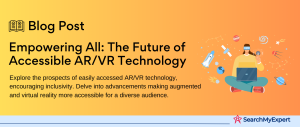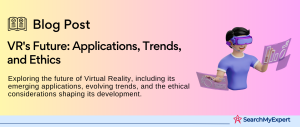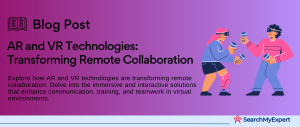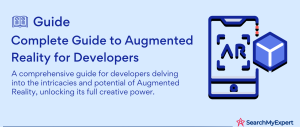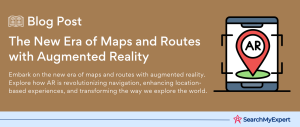The Future of AR & VR
The Dawn of a New Reality: Understanding AR & VR’s Current Landscape and Future Potential
Augmented Reality (AR) and Virtual Reality (VR) stand as beacons of technological innovation, fundamentally transforming our interaction with the digital world. AR enhances our real-world environment by overlaying digital information on it, while VR immerses users in a completely virtual environment. Currently, these technologies are not just futuristic concepts but are actively shaping various industries, from gaming and entertainment to education and healthcare.
Their rising popularity is anchored in their potential to offer more immersive, interactive, and engaging experiences compared to traditional digital platforms. AR & VR technologies are rapidly evolving, becoming more accessible and refined, which suggests a bright future ahead.
Navigating the Evolution: Key Technological Advancements in AR & VR
The realms of Augmented Reality (AR) and Virtual Reality (VR) are experiencing an unprecedented era of growth, driven by remarkable advancements in both hardware and software. These developments are not only enhancing the capabilities of AR and VR technologies but also making them more accessible and affordable for a broader audience. Let’s delve into the key areas of technological development that are shaping the future of AR and VR.
Hardware Breakthroughs: Elevating the Sensory Experience
- Advanced Displays: The quality of AR and VR experiences hinges significantly on display technology. Recent advancements have seen the emergence of higher resolution screens, wider field of view, and faster refresh rates. This progress results in sharper, more realistic visuals, diminishing the gap between virtual and physical realities.
- Haptic Feedback Innovations: Haptic feedback technology has evolved dramatically. From simple vibration feedback to sophisticated gloves and suits that simulate touch, temperature, and even resistance, these innovations are making virtual environments more tactile and immersive.
- Lightweight, Ergonomic Headsets:
Modern AR/VR headsets are becoming lighter and more comfortable, reducing user fatigue. Ergonomics is a crucial factor, with designs focusing on balancing weight and reducing strain on the head and eyes. - Wireless and Standalone Devices: The shift towards wireless and standalone VR headsets, free from the constraints of external hardware, offers users greater freedom of movement and ease of use.
Software Advancements: The Backbone of Immersive Experiences
- Spatial Mapping and Environment Reconstruction:
Advanced spatial mapping technologies allow AR and VR systems to accurately understand and reconstruct the physical environment. This capability enables more seamless integration of virtual objects into real-world settings in AR and richer interaction possibilities in VR. - AI Integration and Machine Learning: The integration of Artificial Intelligence (AI) and Machine Learning (ML) is revolutionizing AR and VR experiences. AI algorithms can enhance image recognition, personalize experiences, and even predict user behavior, leading to more engaging and interactive environments.
- Real-Time Rendering and Graphics: Improvements in real-time rendering and graphics processing have enabled more detailed and complex virtual worlds. These advancements allow for more dynamic lighting, realistic textures, and sophisticated animations.
- Voice and Gesture Recognition:
Enhanced voice and gesture recognition capabilities are making interactions in AR and VR more natural and intuitive. This progress is eliminating the need for traditional controllers, allowing users to navigate and manipulate virtual environments using natural movements and commands.
Increased Accessibility and Affordability: Widening the Reach
- Lowering Cost Barriers:
One of the most significant trends in AR and VR is the reduction in costs. More affordable headsets and AR-capable smartphones are bringing these technologies to a wider audience. - Mobile AR Development:
The proliferation of AR apps on smartphones and tablets has significantly increased accessibility. Users can now experience AR without the need for expensive or specialized equipment. - Cross-Platform Compatibility:
Developments in cross-platform software allow for a more diverse range of devices to support AR and VR applications, further broadening accessibility. - Educational and Development Tools:
The availability of educational resources and development tools is empowering more creators to enter the AR and VR space. Platforms like Unity and Unreal Engine offer accessible ways for developers to create and test AR/VR experiences.
Revolutionizing Industries: The Transformative Impact of AR & VR
Augmented Reality (AR) and Virtual Reality (VR) are not just reshaping our leisure activities but are also revolutionizing a broad spectrum of industries. From gaming to healthcare, these technologies are unlocking new potentials, enhancing efficiency, and offering innovative solutions. Let’s explore how AR and VR are making significant impacts across various sectors.
Gaming and Entertainment: A New Realm of Immersion
- Immersive Gaming Experiences:
AR and VR are elevating gaming to new heights of immersion. VR games transport players into vivid, interactive worlds, while AR games blend digital elements with the real world, offering unique gameplay experiences. - Social VR: Social VR platforms are creating virtual spaces where people can interact, socialize, and collaborate as if they were in the same physical space. These platforms are redefining social interaction in the digital age.
Education and Training: Enhancing Learning through Interactivity
- Interactive Learning Experiences:
In education, AR and VR are providing interactive and engaging learning experiences. Students can explore historical sites, dissect virtual frogs, or even visit distant planets, making learning more dynamic and memorable. - Virtual Training Environments:
VR offers safe, realistic training environments for various professions. From pilots practicing in flight simulators to surgeons honing their skills in virtual operating rooms, VR enables risk-free, practical training.
Healthcare: Advancing Treatment and Training
- Surgery Simulations: VR simulations are becoming crucial in medical training, allowing surgeons to practice complex procedures in a controlled, virtual environment, enhancing their skills without putting patients at risk.
- Remote Consultations:
AR and VR are enabling remote consultations, where doctors can interact with patients or consult with other specialists across distances, improving access to medical care.
Manufacturing and Design: Streamlining Processes
- Prototyping and Design: AR and VR are transforming the design and prototyping stages in manufacturing. Designers can create and iterate virtual models of products, significantly speeding up the design process and reducing costs.
- Remote Collaboration:
These technologies enable remote collaboration in design and manufacturing, allowing teams to work together on projects from different locations, sharing virtual models and designs in real time.
Retail and Marketing: Redefining Consumer Experience
- Augmented Product Showcases:
AR is changing how consumers shop, offering augmented product showcases. Customers can visualize products in their own space before purchasing, enhancing decision-making and satisfaction. - Virtual Try-Ons:
Virtual try-on solutions, particularly in fashion and beauty retail, are allowing customers to try products virtually, from clothes to makeup, providing a new level of convenience and personalization.
Blurring the Lines: The Convergence of AR, VR, and the Metaverse
As we venture deeper into the digital age, the lines between physical reality and virtual worlds are increasingly blurring, thanks to the advancements in Augmented Reality (AR), Virtual Reality (VR), and the burgeoning concept of the metaverse. This convergence is creating a seamless transition between our real-world experiences and digital realms, fostering new forms of interaction, identity, and community. Let’s explore this fascinating interplay of AR, VR, and the metaverse.
Seamless Transitions Between Virtual and Real Worlds
- Integrated Experiences:
The integration of AR and VR with the metaverse is leading to fluid transitions between the real and virtual worlds. AR serves as a bridge, overlaying digital information onto our physical surroundings, while VR offers complete immersion in digital environments. Together, they are creating a cohesive experience where users can smoothly navigate between realities. - Enhanced Realism and Interactivity: With technological advancements, these virtual experiences are becoming more realistic and interactive. Users can manipulate digital objects, experience lifelike simulations, and engage with virtual environments in ways that closely mimic real-world interactions.
Persistent Digital Identities and Avatars
- Digital Personas:
In the metaverse, users can create digital avatars that represent their identities across various platforms and experiences. These avatars offer a consistent identity that persists regardless of the virtual space they inhabit, enabling a sense of continuity and personal expression. - Customization and Representation:
Avatars in the metaverse can be highly customized, reflecting the user’s personality, preferences, and even physical appearance. This level of customization empowers users to represent themselves in unique ways, fostering a diverse digital community.
Challenges and Implications of Virtual Citizenship
- Ethical and Privacy Concerns: As users spend more time in virtual spaces, issues of privacy, data security, and ethical behavior become increasingly significant. The concept of virtual citizenship raises questions about the rights and responsibilities of users within these digital communities.
- Social and Psychological Impact:
The blurred lines between reality and virtuality also bring forward social and psychological considerations. The impact of prolonged immersion in virtual environments on real-world social relationships and mental health is a growing area of concern. - Governance and Regulation:
The metaverse poses unique challenges in terms of governance and regulation. Establishing rules and norms that govern behavior, commerce, and interaction in these spaces is complex, requiring collaboration between technology creators, users, and regulatory bodies.
Navigating the Ethical Terrain: Challenges in AR & VR
As Augmented Reality (AR) and Virtual Reality (VR) technologies advance and become more integrated into our daily lives, they bring not only opportunities but also a host of ethical challenges. These issues range from concerns about privacy and data security to the implications for mental health and societal impact. Understanding and addressing these ethical considerations is crucial for the responsible development and deployment of AR and VR technologies.
Privacy Concerns and Data Security
- Data Collection and Use:
AR and VR technologies collect vast amounts of personal data, including physical movements, facial expressions, and even biometric data. How this data is collected, stored, and used raises significant privacy concerns. - Surveillance and Tracking:
The potential for AR and VR technologies to be used for surveillance purposes, tracking user behavior and interactions, poses a risk to individual privacy rights.
Addiction and Mental Health Implications
- Immersive Nature and Overuse:
The highly immersive nature of AR and VR can lead to excessive use, potentially resulting in addictive behaviors. Balancing immersive experiences with healthy usage patterns is a challenge for developers and users alike. - Impact on Mental Health:
Prolonged exposure to virtual environments may have implications for mental health, including issues related to social isolation, disassociation, or altered perceptions of reality.
Accessibility and Social Divide
- Inclusive Design: There is a risk that AR and VR technologies may not be accessible to all, especially those with disabilities. Ensuring these technologies are designed inclusively is essential to avoid widening the digital divide.
- Economic Barriers:
The cost of AR and VR hardware and the need for high-speed internet access can create a social divide, where only certain segments of the population can afford these technologies.
The blurring of Reality and Virtual Experiences
- Distinguishing Between Real and Virtual:
As AR and VR technologies become more realistic, the line between real and virtual experiences can become blurred. This can lead to confusion, especially in young or impressionable users, and raises questions about the impact on perception and cognition. - Ethical Content Creation:
The content created for AR and VR platforms also poses ethical questions. It’s crucial to consider the psychological effects of the content and the moral implications of the scenarios and experiences being simulated.
Equipping for Tomorrow: Skills and Infrastructure for the AR/VR Era
As Augmented Reality (AR) and Virtual Reality (VR) technologies continue to advance, preparing for their widespread adoption requires not only developing specific skills but also establishing robust infrastructure. This preparation is essential for individuals and organizations alike to capitalize on the opportunities and navigate the challenges presented by these technologies. Let’s explore the key areas of focus in education and training, cybersecurity, ethical frameworks, and public infrastructure investment.
Education and Training Programs for Developers and Creators
- Specialized Curricula: There’s a growing need for educational programs focused on AR and VR development. This includes university courses, online training modules, and workshops that cover everything from basic design principles to advanced programming.
- Cross-Disciplinary Knowledge: Successful AR and VR development requires a blend of skills, including computer science, graphic design, user experience design, and even psychology. Educators should focus on creating cross-disciplinary programs that equip learners with a holistic understanding of these technologies.
- Continuous Learning:
Given the rapid evolution of AR and VR, ongoing education and skill development are crucial. Professionals in the field must stay abreast of the latest tools, trends, and best practices.
Cybersecurity and Ethical Frameworks
- Data Protection Measures:
As AR and VR technologies handle sensitive user data, robust cybersecurity measures are essential. This includes encryption, secure data storage, and privacy protection features. - Ethical Guidelines:
Developing and adhering to ethical guidelines is crucial in AR and VR development. This encompasses considerations around user privacy, content moderation, and the psychological impact of immersive technologies.
Investment in Public Infrastructure
- High-Speed Internet Access:
The effectiveness of AR and VR technologies largely depends on high-speed internet connectivity. Investment in Internet infrastructure, especially in underserved areas, is crucial for the democratization of these technologies. - Public-Private Partnerships: Collaboration between the public sector and private companies can accelerate the development of necessary infrastructure. This includes funding for research initiatives, technology hubs, and innovation centers.
- Accessible Public Spaces for AR/VR:
Creating public spaces equipped with AR/VR technologies can provide broader access and encourage communal and educational use of these technologies.
Building a Supportive Ecosystem
- Innovation Incubators and Accelerators: Establishing incubators and accelerators focused on AR and VR can help nurture startups and innovations in this field, driving growth and adoption.
- Community Building: Fostering a community of AR/VR enthusiasts, developers, and users can facilitate knowledge sharing, collaboration, and support. This can be achieved through conferences, online forums, and local meetups.
Embracing the Future: The Promise and Challenges of AR & VR
The potential of Augmented Reality (AR) and Virtual Reality (VR) to revolutionize our world is immense. These technologies offer groundbreaking opportunities across various sectors – from gaming and entertainment to education, healthcare, and beyond. They promise to enhance our experiences, deepen our understanding, and expand our capabilities in ways previously imagined only in science fiction.
However, as with any transformative technology, AR and VR also present significant challenges. Issues surrounding privacy, data security, ethical use, and the psychological impact on users are paramount. Additionally, the risk of deepening the digital divide through uneven access to these technologies is a concern that needs addressing. As we integrate AR and VR more deeply into our social fabric, it’s crucial to tackle these challenges head-on.
Conclusion:
As we look toward the horizon, the potential of Augmented Reality (AR) and Virtual Reality (VR) in reshaping our world is undeniable. These technologies, with their ability to blend, augment, and create realities, are not just tools for innovation but catalysts for change across various sectors. Yet, as we embrace their vast possibilities, we are also tasked with navigating the complex challenges they present, from ethical dilemmas to technological barriers. The future of AR and VR is a tapestry of immense potential woven with intricate challenges. It is a future that calls for responsible stewardship, creativity, and collaboration. As we step into this new era, our collective action and foresight will determine how these groundbreaking technologies enhance, augment, and elevate our societal fabric. Let us embrace this future with a commitment to harnessing AR and VR for the betterment of society, ensuring that they serve as bridges to a more connected, immersive, and empathetic world.
Bring the power of AR/VR to your fingertips with our AR & VR Development Service Services.
Table of Contents
Toggle

